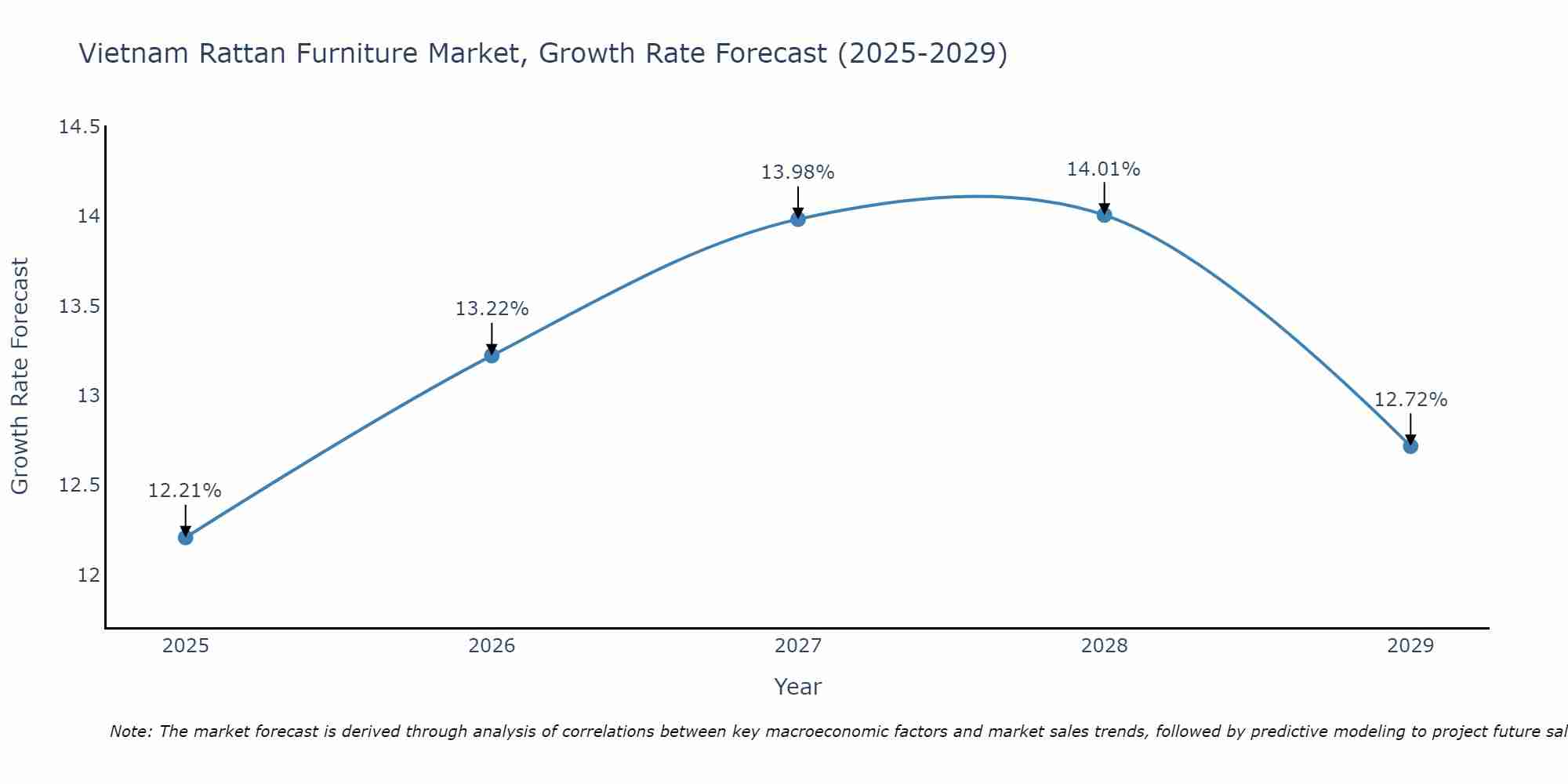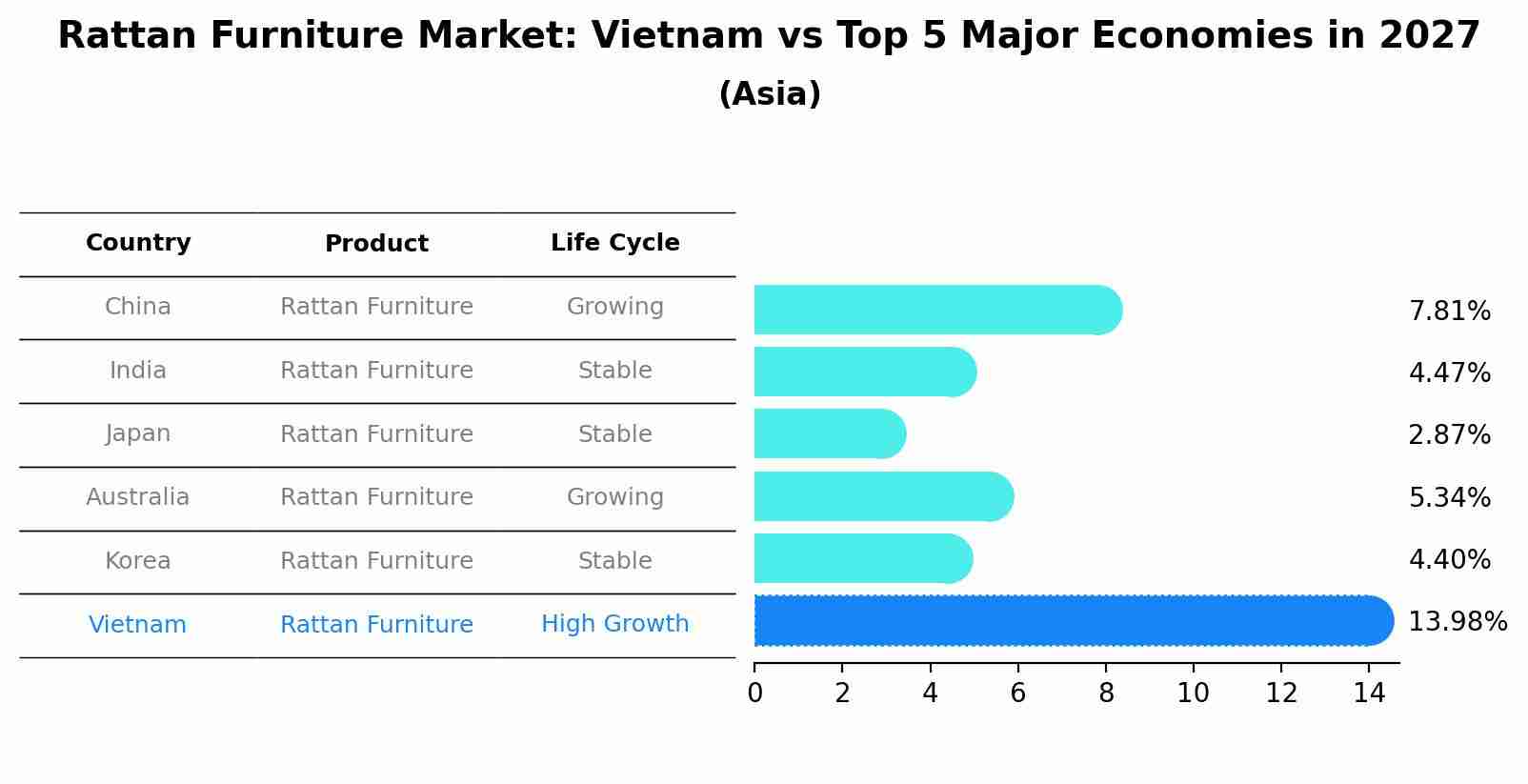Vietnam Rattan Furniture Market (2025-2031) Outlook | Share, Trends, Companies, Analysis, Forecast, Size, Industry, Growth, Value & Revenue
| Product Code: ETC372990 | Publication Date: Aug 2022 | Updated Date: Apr 2025 | Product Type: Market Research Report | |
| Publisher: 6Wresearch | No. of Pages: 75 | No. of Figures: 35 | No. of Tables: 20 | |
Vietnam Rattan Furniture Market Size Growth Rate
The Vietnam Rattan Furniture Market is projected to witness mixed growth rate patterns during 2025 to 2029. Growth accelerates to 14.01% in 2028, following an initial rate of 12.21%, before easing to 12.72% at the end of the period.

Rattan Furniture Market: Vietnam vs Top 5 Major Economies in 2027 (Asia)
By 2027, the Rattan Furniture market in Vietnam is anticipated to reach a growth rate of 13.98%, as part of an increasingly competitive Asia region, where China remains at the forefront, supported by India, Japan, Australia and South Korea, driving innovations and market adoption across sectors.

Vietnam Rattan Furniture Market Synopsis
Rattan furniture holds a significant presence in the Vietnamese furniture market, known for its craftsmanship and eco-friendliness. Rattan furniture is not only popular domestically but also finds a place in the global market due to its unique aesthetic appeal. The market has benefited from the growing awareness of sustainable and natural materials in furniture production. Vietnamese artisans are renowned for their intricate weaving techniques, contributing to the allure of rattan furniture. With consumers showing a preference for eco-friendly and stylish furniture, the rattan furniture market in Vietnam continues to flourish.
Drivers of the Market
The Vietnam rattan furniture market is flourishing due to several driving factors. Firstly, there is a growing trend towards eco-friendly and sustainable furniture choices, and rattan fits this criterion perfectly. Consumers are increasingly conscious of the environmental impact of their purchases, driving demand for rattan furniture, which is both renewable and biodegradable. Additionally, the unique and aesthetically pleasing designs of rattan furniture are gaining popularity among homeowners and businesses alike. Moreover, the availability of skilled craftsmanship in Vietnam further enhances the market`s growth, as artisans can create intricate and high-quality rattan pieces. Furthermore, the export potential of Vietnamese rattan furniture contributes to its expansion, as it finds a global market interested in both its craftsmanship and sustainability.
Challenges of the Market
The Vietnam rattan furniture market faces challenges due to environmental sustainability and competition from synthetic materials. Rattan is a natural resource, and its overharvesting can lead to environmental degradation. Manufacturers need to adopt sustainable harvesting practices and explore alternatives to traditional rattan. Moreover, synthetic materials like plastic rattan are becoming popular due to their durability and low maintenance, posing a competitive challenge to traditional rattan furniture.
COVID-19 Impact on the Market
The Vietnam rattan furniture market faced challenges during the pandemic, with disruptions in the supply chain and reduced consumer spending on non-essential items. However, as consumers sought sustainable and eco-friendly options for home furnishings, there was a renewed interest in rattan furniture, albeit at a slower pace.
Key Players in the Market
In the Vietnam rattan furniture market, several manufacturers stand out for their craftsmanship and design. One of the prominent players is Mai Home, known for its handcrafted rattan furniture pieces that combine traditional Vietnamese techniques with contemporary designs. Another key player is DUY TAN Rattan, which offers a diverse range of rattan furniture options and exports its products globally.
Key Highlights of the Report:
- Vietnam Rattan Furniture Market Outlook
- Market Size of Vietnam Rattan Furniture Market, 2024
- Forecast of Vietnam Rattan Furniture Market, 2031
- Historical Data and Forecast of Vietnam Rattan Furniture Revenues & Volume for the Period 2021-2031
- Vietnam Rattan Furniture Market Trend Evolution
- Vietnam Rattan Furniture Market Drivers and Challenges
- Vietnam Rattan Furniture Price Trends
- Vietnam Rattan Furniture Porter's Five Forces
- Vietnam Rattan Furniture Industry Life Cycle
- Historical Data and Forecast of Vietnam Rattan Furniture Market Revenues & Volume By Type for the Period 2021-2031
- Historical Data and Forecast of Vietnam Rattan Furniture Market Revenues & Volume By Table for the Period 2021-2031
- Historical Data and Forecast of Vietnam Rattan Furniture Market Revenues & Volume By Chairs for the Period 2021-2031
- Historical Data and Forecast of Vietnam Rattan Furniture Market Revenues & Volume By Storage for the Period 2021-2031
- Historical Data and Forecast of Vietnam Rattan Furniture Market Revenues & Volume By Beds for the Period 2021-2031
- Historical Data and Forecast of Vietnam Rattan Furniture Market Revenues & Volume By Others for the Period 2021-2031
- Historical Data and Forecast of Vietnam Rattan Furniture Market Revenues & Volume By Application for the Period 2021-2031
- Historical Data and Forecast of Vietnam Rattan Furniture Market Revenues & Volume By Residential for the Period 2021-2031
- Historical Data and Forecast of Vietnam Rattan Furniture Market Revenues & Volume By Commercial for the Period 2021-2031
- Historical Data and Forecast of Vietnam Rattan Furniture Market Revenues & Volume By Distribution Channel for the Period 2021-2031
- Historical Data and Forecast of Vietnam Rattan Furniture Market Revenues & Volume By Multi-brand Stores for the Period 2021-2031
- Historical Data and Forecast of Vietnam Rattan Furniture Market Revenues & Volume By Exclusive Stores for the Period 2021-2031
- Historical Data and Forecast of Vietnam Rattan Furniture Market Revenues & Volume By Online for the Period 2021-2031
- Historical Data and Forecast of Vietnam Rattan Furniture Market Revenues & Volume By Other Distribution Channel for the Period 2021-2031
- Vietnam Rattan Furniture Import Export Trade Statistics
- Market Opportunity Assessment By Type
- Market Opportunity Assessment By Application
- Market Opportunity Assessment By Distribution Channel
- Vietnam Rattan Furniture Top Companies Market Share
- Vietnam Rattan Furniture Competitive Benchmarking By Technical and Operational Parameters
- Vietnam Rattan Furniture Company Profiles
- Vietnam Rattan Furniture Key Strategic Recommendations
Frequently Asked Questions About the Market Study (FAQs):
- Single User License$ 1,995
- Department License$ 2,400
- Site License$ 3,120
- Global License$ 3,795
Search
Related Reports
- ASEAN Bearings Market (2025-2031) | Strategy, Consumer Insights, Analysis, Investment Trends, Opportunities, Growth, Size, Share, Industry, Revenue, Segments, Value, Segmentation, Supply, Forecast, Restraints, Outlook, Competition, Drivers, Trends, Demand, Pricing Analysis, Competitive, Strategic Insights, Companies, Challenges
- Europe Flooring Market (2025-2031) | Outlook, Share, Industry, Trends, Forecast, Companies, Revenue, Size, Analysis, Growth & Value
- Saudi Arabia Manlift Market (2025-2031) | Outlook, Size, Growth, Trends, Companies, Industry, Revenue, Value, Share, Forecast & Analysis
- Uganda Excavator, Crane, and Wheel Loaders Market (2025-2031) | Strategy, Consumer Insights, Analysis, Investment Trends, Opportunities, Growth, Size, Share, Industry, Revenue, Segments, Value, Segmentation, Supply, Forecast, Restraints, Outlook, Competition, Drivers, Trends, Demand, Pricing Analysis, Competitive, Strategic Insights, Companies, Challenges
- Rwanda Excavator, Crane, and Wheel Loaders Market (2025-2031) | Strategy, Consumer Insights, Analysis, Investment Trends, Opportunities, Growth, Size, Share, Industry, Revenue, Segments, Value, Segmentation, Supply, Forecast, Restraints, Outlook, Competition, Drivers, Trends, Demand, Pricing Analysis, Competitive, Strategic Insights, Companies, Challenges
- Kenya Excavator, Crane, and Wheel Loaders Market (2025-2031) | Strategy, Consumer Insights, Analysis, Investment Trends, Opportunities, Growth, Size, Share, Industry, Revenue, Segments, Value, Segmentation, Supply, Forecast, Restraints, Outlook, Competition, Drivers, Trends, Demand, Pricing Analysis, Competitive, Strategic Insights, Companies, Challenges
- Angola Excavator, Crane, and Wheel Loaders Market (2025-2031) | Strategy, Consumer Insights, Analysis, Investment Trends, Opportunities, Growth, Size, Share, Industry, Revenue, Segments, Value, Segmentation, Supply, Forecast, Restraints, Outlook, Competition, Drivers, Trends, Demand, Pricing Analysis, Competitive, Strategic Insights, Companies, Challenges
- Israel Intelligent Transport System Market (2025-2031) | Strategy, Consumer Insights, Analysis, Investment Trends, Opportunities, Growth, Size, Share, Industry, Revenue, Segments, Value, Segmentation, Supply, Forecast, Restraints, Outlook, Competition, Drivers, Trends, Demand, Pricing Analysis, Competitive, Strategic Insights, Companies, Challenges
- Uganda Precast and Aggregate Market (2025-2031) | Strategy, Consumer Insights, Analysis, Investment Trends, Opportunities, Growth, Size, Share, Industry, Revenue, Segments, Value, Segmentation, Supply, Forecast, Restraints, Outlook, Competition, Drivers, Trends, Demand, Pricing Analysis, Competitive, Strategic Insights, Companies, Challenges
- Australia IT Asset Disposal Market (2025-2031) | Strategy, Consumer Insights, Analysis, Investment Trends, Opportunities, Growth, Size, Share, Industry, Revenue, Segments, Value, Segmentation, Supply, Forecast, Restraints, Outlook, Competition, Drivers, Trends, Demand, Pricing Analysis, Competitive, Strategic Insights, Companies, Challenges
Industry Events and Analyst Meet
Our Clients
Whitepaper
- Middle East & Africa Commercial Security Market Click here to view more.
- Middle East & Africa Fire Safety Systems & Equipment Market Click here to view more.
- GCC Drone Market Click here to view more.
- Middle East Lighting Fixture Market Click here to view more.
- GCC Physical & Perimeter Security Market Click here to view more.
6WResearch In News
- Doha a strategic location for EV manufacturing hub: IPA Qatar
- Demand for luxury TVs surging in the GCC, says Samsung
- Empowering Growth: The Thriving Journey of Bangladesh’s Cable Industry
- Demand for luxury TVs surging in the GCC, says Samsung
- Video call with a traditional healer? Once unthinkable, it’s now common in South Africa
- Intelligent Buildings To Smooth GCC’s Path To Net Zero













